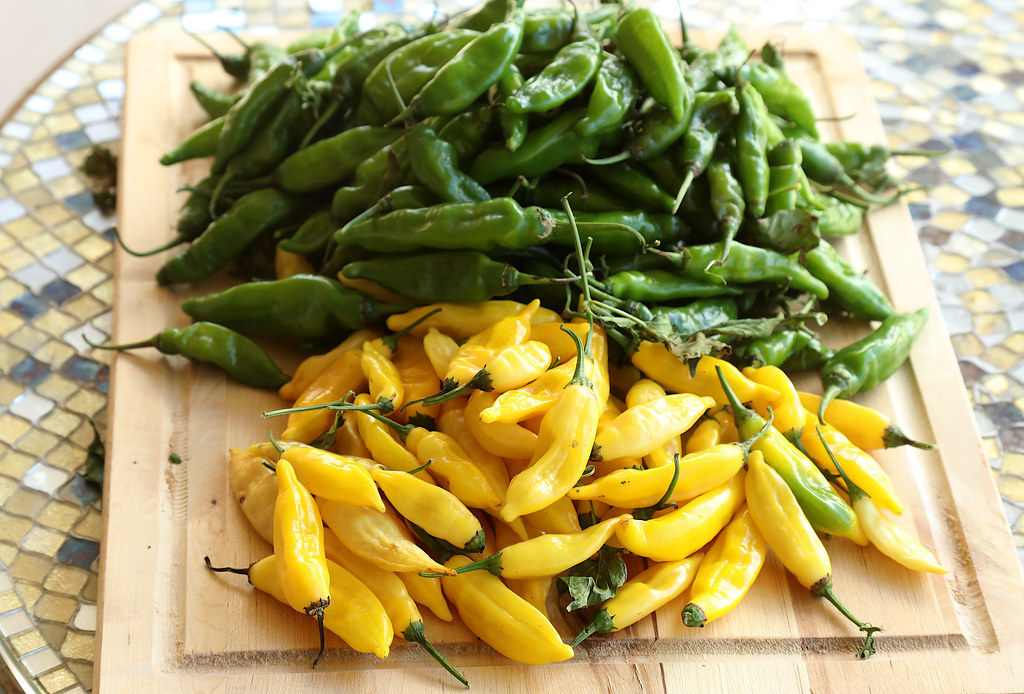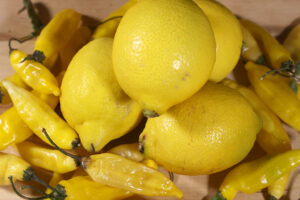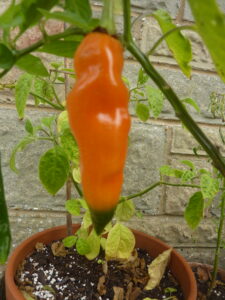Aji Amarillo
Overview
The Aji Amarillo, a vibrant yellow chili, is the backbone of Peruvian cuisine, valued for its moderate heat and depth of flavor. As a staple in many traditional dishes, it introduces a distinct taste that transforms soups and sauces. Its cultivation traces back to ancient South America, now finding its way into gardens and dishes globally. This tall plant with striking orange-yellow pods adds not only spice but a touch of history to every meal it graces.

Characteristics
Known for its bright orange-yellow color, medium heat level, and prominence in Peruvian cuisine.
Region
Native to South America and grown in regions such as Peru, also introduced to Hawaii, Central America, India, the United States, and Australia.
Natural Habitat
In the wild, the Aji Amarillo plant is usually found in mountainous regions of South America.
Cultivation
Requires full sun, regular watering to keep soil moist but not waterlogged, and well-drained, fertile soil with a pH between 6 and 6.8.
Uses and Benefits
The Aji Amarillo pepper (Capsicum baccatum) is a culinary gem that brings warmth and depth to your dishes. Its fruity, complex flavor profile adds an inviting touch of heat, similar to jalapeño or serrano peppers.1 This vibrant chili isn’t just a pretty face in the garden – it’s a hardworking ingredient that elevates everyday cooking.
Aji Amarillo’s benefits extend beyond its tastebud-tempting qualities:
- Versatility: From sauces to soups, this pepper brings a golden glow and irresistible flavor to a wide range of recipes.
- Easy to grow: Aji Amarillo thrives in home gardens, making it a rewarding choice for pepper enthusiasts and culinary gardeners alike.
- Health-boosting: Packed with vitamins A and C, these peppers support eye health and immune function while adding a burst of nutrition to your plate.
To make the most of your homegrown Aji Amarillo peppers, harvest them when they’ve ripened to a brilliant, sunny orange. This signals peak flavor and heat, ensuring your dishes are blessed with the full depth of their deliciousness.
So why not add a little Peruvian-inspired flair to your kitchen? Embrace the warm, inviting heat of Aji Amarillo peppers and let your culinary creativity flourish.

Cultivation Tips
To cultivate Aji Amarillo peppers successfully, patience is key. These vibrant beauties take their time to mature, requiring approximately 2 to 3 months from the moment their flowers bloom until the fruits ripen5. Keep an eye out for the peppers to shift from green to a bright orange-yellow hue, signaling they are ready to harvest.
Waiting for this crucial color change is important, as it’s not just about aesthetics; it’s the pepper’s way of indicating it has reached peak flavor and is ready to add a delightful kick to your dishes5. A bit of anticipation will make the harvest all the more rewarding!
For a bountiful Aji Amarillo harvest, consider the following tips:
- Start seeds indoors 6-8 weeks before the last expected frost date in your area
- Transplant seedlings outdoors when the risk of frost has passed and nighttime temperatures consistently stay above 50°F (10°C)
- Choose a sunny location with well-draining soil rich in organic matter
- Space plants 18-24 inches apart to allow for proper growth and air circulation
- Water regularly, ensuring the soil remains moist but not soggy
- Fertilize every 2-3 weeks with a balanced, water-soluble fertilizer to support healthy growth and fruit development
With a little patience and proper care, you’ll soon be enjoying the unique, fruity heat of homegrown Aji Amarillo peppers in your favorite dishes!
Seasonal Considerations
To cultivate Aji Amarillo peppers successfully, patience is key. These vibrant beauties take their time to mature, requiring approximately 2 to 3 months from the moment their flowers bloom until the fruits are ready to harvest5. As you tend to your peppers, keep a watchful eye for the telltale sign of ripeness: a stunning transition from green to a bright orange-yellow hue.
Waiting for this color change is crucial, as it’s not just about aesthetics; it’s the pepper’s way of signaling that it’s reached peak flavor and is ready to add its unique kick to your culinary creations5. The anticipation may be challenging, but trust that the reward of a bountiful, flavorful harvest will be well worth the wait!
To ensure a successful Aji Amarillo harvest, consider the following seasonal tips:
- Start seeds indoors 6-8 weeks before the last expected frost in your area
- Transplant seedlings outdoors once the risk of frost has passed and temperatures consistently remain above 60°F (15°C)
- Provide your peppers with plenty of sunlight, aiming for at least 6 hours of direct sun per day
- Water regularly, keeping the soil moist but not soggy, and adjust watering frequency based on rainfall and temperature
- Apply a balanced, slow-release fertilizer once a month to support healthy growth and fruit development
- Monitor your plants for signs of pests or disease, and address any issues promptly to maintain plant health
By following these guidelines and exercising a bit of patience, you’ll be well on your way to enjoying a bountiful harvest of flavorful, vibrant Aji Amarillo peppers that will elevate your dishes and impress your taste buds!

Issues and Troubleshooting
While the Aji Amarillo herb is robust and rewarding to grow, it’s not without its challenges. Occasionally, gardeners might grapple with common pepper plant issues such as pests and diseases.
Pests:
- Aphids and spider mites could take a liking to your pepper plants.
- Regular monitoring of your Aji Amarillo will help catch these issues early on, making them easier to control.
- If issues do arise, treatments such as insecticidal soaps can be effective1.
Diseases:
- Fungal diseases like leaf spot or powdery mildew might appear if conditions are too damp.
- Ensuring good air circulation, adequate sunlight, and proper watering can often prevent or alleviate these problems.
- If issues do arise, fungicidal sprays can be effective for treating mildew1.
To reduce disease carryover, it’s wise to:
- Rotate crops
- Avoid planting peppers in the same spot year after year
With proper care and attention, you can successfully troubleshoot any issues that may arise with your Aji Amarillo plants and enjoy a bountiful harvest.
History and Folklore
The Aji Amarillo is more than just a pepper; it’s a fragment of history that traces back to ancient Peru around 2500 B.C.4 With its deep roots in native culture, this vibrant orange-yellow chili has been warming the palates and hearts of people for centuries. The Aji Amarillo’s journey from the hands of Native Americans has seen it spread across the globe, traveling to far-off places like Hawaii, Central America, India, the United States, and Australia.4
A symbol of tradition and flavor, the Aji Amarillo is not only pivotal in Peruvian cuisine but also a cherished piece of agricultural folklore. Its story whispers through the ages, a testament to the enduring bond between humans and the earth’s bounties. For generations, this pepper has been a staple in the diets of indigenous peoples, who have cultivated and preserved its unique qualities.
The Aji Amarillo’s rich history is interwoven with the cultural fabric of Peru, where it has been used in traditional dishes and medicinal remedies for centuries. Its vibrant color and distinctive flavor have made it a beloved ingredient in the nation’s culinary landscape, from the ancient Inca civilization to modern-day kitchens.
As the Aji Amarillo has traveled beyond the borders of its native land, it has become a global ambassador for Peruvian culture and cuisine. Its presence in international markets and restaurants has helped to showcase the rich agricultural heritage of Peru and has sparked a growing interest in the country’s diverse and flavorful ingredients.
The enduring popularity of the Aji Amarillo is a testament to its versatility, flavor, and cultural significance. As home gardeners and wildcrafters continue to cultivate this beloved pepper, they are not only preserving a piece of history but also ensuring that future generations can enjoy its unique qualities and appreciate its rich cultural legacy.
References
1. Pepper Geek. “Aji Amarillo – A Staple Peruvian Pepper Variety.” https://peppergeek.com/aji-amarillo/
2. Backyard Gardener. “Capsicum baccatum ( Aji Amarillo Capsicum Pepper ).” https://www.backyardgardener.com/plantname/capsicum-baccatum-aji-amarillo-capsicum-pepper/
3. The Spruce Eats. “Grow Your Own Aji Amarillo, Peruvian Yellow Chilies.” https://www.thespruceeats.com/grow-your-own-peruvian-yellow-peppers-3973828
4. Health Benefits Times. “Aji Amarillo Facts, Health Benefits and Nutritional Value.” https://www.healthbenefitstimes.com/aji-amarillo/
5. Chili Craze. “How To Grow Aji Amarillo Peppers – The Ultimate Guide.” https://chilicraze.com/how-to-grow/aji-amarillo/
Image Credit: cold_penguin1952 Attribution-NonCommercial-ShareAlike License
Image Credit: cold_penguin1952 Attribution-NonCommercial-ShareAlike License
Image Credit: AndyRobertsMusicIOW Attribution License
Nicolas Duval
Nicolas is a passionate advocate for nature and the art of wildcrafting. His dedication shines through in Wildcraftia, a website he meticulously crafted to serve as a haven for nature enthusiasts worldwide. Driven by a deep appreciation for nature’s connection to humanity, Nicolas embarked on his journey in 2011 with SmokableHerbs, a platform showcasing his love for nature’s bounty. Building upon this foundation, he established Smokably, a thriving online store offering premium herbs and blends to a global audience.
